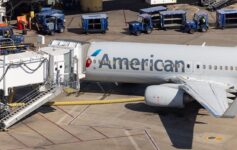
It’s not only understandable why pilots want more longhaul flights at American Airlines…it’s also logical. But American Airlines has chosen a different path and I’m not sure pilots…or customers…are going to change it.
American Airlines Pilots Want More Longhaul Flights, Decry Current AA Business Model
Captain Ed Sicher, the president of the Allied Pilots Association (APA) representing pilots at American Airlines, posted an open letter to management at AA. The letter is almost 1,000 words long, but I find it worth considering in full, including the title: “1995 Just Called – America West Wants Its Business Model Back.”
American Airlines management has been busy for the past few weeks. For the first time in seven years, management hosted an “Investor Day” on March 4, using it to unveil portions of their updated business plan. The Investor Day and the J.P. Morgan Industrials Conference that followed gave us a peek into the company’s strategy and how it may affect our future flying.
Unfortunately, the news isn’t good from our pilots’ perspective. Chief Executive Officer Robert Isom sees future profitability as dependent on growth opportunities in underserved domestic markets, with the crux of his business plan revolving around these marginal locations. In other words, the airline management team responsible for producing profit margins that badly lag those of Delta and United believes that opportunity beckons by taking on Southwest Airlines and the ultra low-cost carriers. Not mentioned once: defending the cornerstone cities that American Airlines’ historical business plan was built on, which produced a revenue premium.
In his Investor Day remarks, Chief Commercial Officer Vasu Raja emphasized that “short haul is the foundation of value for customers and investors.” The importance of the Sun Belt, upgauging the airline (flying larger airplanes to smaller cities), and improving the domestic network were his primary focus. He mentioned “opportunities in El Paso” more than a dozen times. At least there’s good news if you happen to live in El Paso. But where are the legitimate opportunities for future growth that produce profits?
Vasu remarked that long haul will be used “only when demand peaks,” signaling an intention to revert to the regional operation this America West management team cut its teeth on, albeit on a larger scale.
Chief Operating Officer David Seymour followed up with an emphasis on operational reliability improvements and the airline’s ability to recover from IROPS “better than anyone else,” but he made little mention of how his original schedule construction will change to build robustness into the system from the get-go, thus avoiding the need to put the operation back together in the first place. He also didn’t address our persistently high reserves head count that far exceeds the industry average. American Airlines puts thousands of pilots on reserve who could be holding lines and flying more predictable, profitable, and efficient schedules. Our average reserve pilot flies approximately 55 hours each month, while the average lineholder flies more than 85 hours. Efficiency takes a back seat to reliability as long as David chases on-time metrics and emphasizes reliability while leaving thousands of reserve “firemen” on the schedule to put out the inevitable fires when his computer-generated schedules fall apart.
Boeing recently relearned the hard way that ignoring input from its most valuable resource, its employees, is not in a company’s best interests. Yet American Airlines management seems intent on doing the same things over and over while expecting different results. Our schedules have been broken since before emerging from the pandemic. Narrowbody trips continue getting longer and more onerous. Average line values have not moved down appreciably, our trips haven’t been broken up into more manageable pieces that our pilots can pick up between large chunks of flying, and our trip trade lights have remained stubbornly red since David locked them down in September of 2022. Despite the promises, we’ve witnessed little if any actual improvement.
Management’s “new” business plan doesn’t include a focus on improving operational efficiencies and instead centers on future short-haul revenue opportunities that may or may not produce profits. As we have seen from the recent foray into Austin, these well-intentioned plans are typically money-losers. The profits are almost never in line with our competition at Delta and United, which see the benefit of catering to the premium, business, and international customers that American Airlines appears to be abandoning.
There is another problem with the new business plan. The increased emphasis on short-haul domestic flying also leaves the company on an inevitable collision course with our Scope clause. Section 1 of our contract is the foundation of our flying agreement, capping management’s ability to fly regional jets while also limiting their ability to fly from non-hub cities to other non-hub cities with RJs (spoke-to-spoke). This was the source of the most recent Scope violation that we arbitrated in February, with the arbitrator’s decision pending. The only ways out of this “square corner” the new business plan creates are absorbing one or more of the wholly owned operations, putting RJs on our seniority list, or attempting to renegotiate our Scope clause, and the latter will most certainly be met with virulent opposition.
Investors didn’t like what management had to say, with American’s stock dropping while Delta’s touched a year-to-date high. It’s unclear why management wants to play in the ULCCs’ sandbox and try to compete for their price-conscious customers instead of fortifying and defending the strong hubs we once had in cities like New York that historically produced a revenue premium. If our paltry profit-sharing checks are any indication of the plan’s efficacy, we’re in trouble. The decisions made in the front office don’t bode well for those of us who thought we were being hired by a mainline flag-carrying airline that would provide us with widebody long-haul opportunities and remain solvent in the next inevitable downturn. America West 2.0?
As your advocates, we will continue voicing our concerns to management about their stated plans. While we don’t run the airline, we possess a tremendous amount of institutional knowledge thanks to serving as the airline’s frontline leadership. We see firsthand what works and what doesn’t, and we understand what’s in our best interests as pilots. We are convinced American Airlines needs a significant course correction, and we stand ready to help make that happen by working collaboratively with management, provided management is willing to work with us.
Like One Mile At A Time, I want the same thing pilots want, but for different reasons. As someone who loves to travel the world and loves longhaul lights, I would love to see more longhaul flights on American Airlines. I would love to see American fly to more cities as United Airlines has done to places like Cape Town, Christchurch, Dubai, Manila, and Tahiti.
The pilots want more longhaul routes for two reasons. First, because it is far easier to rack up hours each month. One 10-hour flight or five two-hour flights? That’s an easy choice for virtually every pilot: the longer the flight, the easier it is to bank hours. Second, because pilots want American Airlines to earn more profit (which means more profit sharing). The current strategy of focusing on domestic has led to much smaller margins, and therefore lower profit sharing, than at Delta Air Lines or United.
But here’s why I think the letter is reasonable, but will fall on deaf errors. It feels to me like AA has ceded longhaul flying outside of Latin America and traditional hotspots like London, Sydney, Madrid, and Paris. Of course, it flies to far more cities around the world, but it has chosen a different path than United: it wants to fully cover the domestic route map and offer an alternative to Southwest Airlines and the budget carriers it competes against.
Who’s to say that if American suddenly shifted to focus to longhaul, margins would be any better? And let’s not forget that aircraft delivery delays have made curbed some of AA’s longhaul growth plans.
CONCLUSION
It’s not that I disagree with Sicher’s note. I think “world’s largest airline” (depending upon what metric you use) should have a robust international route network. But American has tried in many markets and walked away…at least its domestic focus is a strategy that might differentiate itself from Delta and United, perhaps even in a good way.
What do you think of the pilot’s letter?
image: APA // Hat Tip: View From The Wing




“American Airlines Pilots Demand More Longhaul Flights”
“we understand what’s in our best interests as pilots.”
Does American Airlines exist to serve the needs of the employees or the traveling public?
Neither. It exists to serve the executives, the board, and the shareholders.
“Does American Airlines exist to serve the needs of the employees or the traveling public?“
Uh, legally, it’s shareholders.
Then they should all be fired based on the results.
Who should be fired? Management? The Board? I don’t disagree. Surely you don’t mean the shareholders?
Yes, upper management and the board based on results.
@David … The “traveling public” is merely a herd of sheep to be fleeced . Hello ?
Fair enough. But the needs of the shareholders are typically best met when the company fills the needs of the consumer and not the employee.
I get it. AA is a hot mess. I used to fly them religiously, to the tune of just over 500,000 lifetime miles. I’ve stepped foot on their plans maybe twice in the last 3 years.
@David … No airline management sees the “consumer” as anything but an automatic ATM . ( Fees ? )
Widebody pilots also get paid more per hour, so it’s a recruiting tactic that DL/UA have for pilots while with AA it’s probably 5-10 more years of seniority required to move up to widebody given the smaller percentage of flying.
At this point AA is competing with LCCs for pilots since there’s much more limited opportunity for growth, not to mention that the higher pay results in higher union dues.
The number one rule for success is to treat your employees well and profit and happy customers will follow.
It’s been proven time and time again.
It’s why companies like Apple are such leaders in the customer experience space, they take good care of their employees. The same for Costco, Delta Airlines, Trader Joes, etc etc. The list goes on and on.
If you treat your employees like they work at Walmart and pay them like they work at Walmart, your customers are gonna feel like they are in Walmart.
If AA wants to make a premium product and attract premium customers that are willing to pay a premium for it all, then they need to pony up the cash and invest in it.
Aircraft, amenities, lounges, long haul international routes, terminals, and MOST importantly living wages and work/life balance for their front line employees.
American has been in a race to the bottom for quite some time. At this point they’re more submarine than airline.
So they don’t wanna necessarily WORK for the money (10 2 hour flights), but rather slum in the cockpit watching the plane fly itself for 10 hours in one flight. Why not! Pay ’em by the take off and landing, that’s where the real work is.
Couldn’t have said it better myself.
What does this mean? “our trip trade lights have remained stubbornly red since David locked them down in September of 2022.”
It sounds like they can’t get enough pilots to trade trips because the schedules are too onerous?
Maybe the most junior pilots on reserve are all in a thither about their “work/life balance” and don’t fully comprehend what “rerserve” means.
AA’s biggest asset at the moment is its network and scale, and their management is rightfully trying to capitalize on it. Small and midsize domestic cities often command high fares, where non-strategic long haul flying can be a notorious money suck. The fact they brought up the “failed” foray into AUS as an example and then immediately listed the the real reason it failed i.e. their own scope clause preventing Eagle focus city flying was especially laughable. The “cornerstones” this seems to fondly reminisce about was AA’s failed strategy under Arpey that led to bankruptcy and the current America West team they’re deriding being able to takeover in the first place.
Yes, but your assertion partly implies that nothing has changed since 2013 when indeed much has. Network and scale are also assets of DL and UA. They manage to deliver far better shareholder results these days.
DL and UA have withdrawn from plenty of smaller markets as they have much more restrictive scope clauses. One of United Next’s goals is to improve connectivity over its interior hubs to better compete in high/yielding markets. AA doesn’t offer the premium branded experience of a DL, their biggest strength currently is that they can take you to more places, more often than DL and UA can. If they lost that by favoring exotic long haul flying, they would have no market advantage and be in an even worse position. It’s funny that APA complained about how Arpey’s Cornerstone strategy was a failed business model biting the 2000’s and now they’re nostalgic for it. APA has to be one of the more miserable pilot groups in the industry and the legacy split US East and West nonsense folded into it doesn’t help.
It’s interesting how AA is spinning this. I’m sure the company has many opportunities to fully flesh out its hubs. ORD for one, has fewer flights than before C0vid. PHL seems to be an unwanted stepchild, even though it was US’s primary transatlantic hub.
So building up its domestic service doesn’t, on its face, sound like a bad idea.
But I don’t understand what that means in terms of emphasizing “short haul” unless AA means BOIDFWMSY is “short haul” as compared to transoceanic service.
American just ordered 90 EMB-175’s without detailing how they are going to be used. This order could be a 1-for-1 replacement for the 90 CR7’s Skywest operates for AAE, but that will run into scope issues if AA configures them for more than 65 seats. AA is at or near its hard cap for the number of 70/76 seaters it can operate without expanding the mainline narrowbody fleet, and given the number of narrow bodies on order, even including the MAX 10’s, that doesn’t seem likely.
There’s something going on here and AA’s talk about “short haul” is unsettling at beast and alarming at worst.
“While we don’t run the airline, we possess a tremendous amount of institutional knowledge thanks to serving as the airline’s frontline leadership.” Is it in the AA pilots contract that they are the “front line leadership”??? While unhappy pilots are not isolated to AA, I have yet to see or read about any unionized pilot groups willingness to assist in running an airline without first extending their hand, palm up for more money.